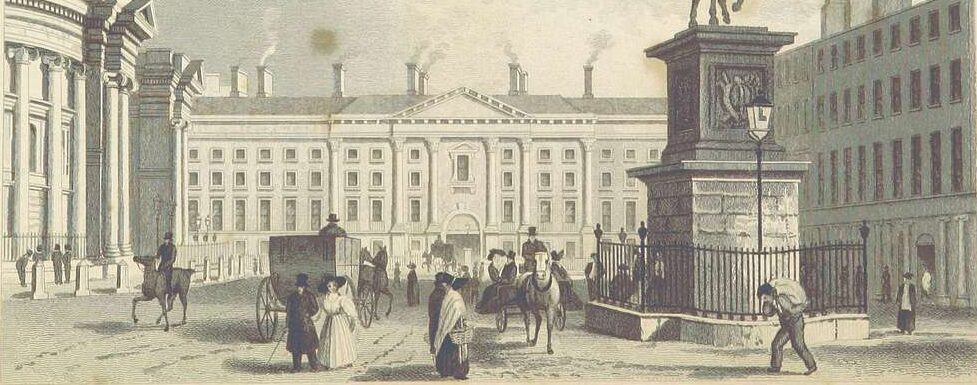 In my previous post in this series, I argued (yet again) that Collins v FBD Insurance plc [2013] IEHC 137 (14 March 2013) was wrongly decided. It precludes a claim for damages for distress for breach of data protection rights, pursuant to section 7 of the Data Protection Act, 1988 (also here) [hereafter: section 7 DPA88]. Building on a case in which the Workplace Relations Commission ordered a company, whose CEO hacked into an employee’s phone and downloaded intimate photos of her from it, to pay her a total of €94,708 damages, I argued that, if the surreptitious download had occurred outside an employment relationship, the complainant should be able to recover damages for distress for breach of her data protection rights, pursuant to section 7 DPA88. However, when the Supreme Court was presented with an opportunity to depart from Collins, it did not take it. Instead, in Murphy v Callinan [2018] IESC 59 (30 November 2018) Baker J (Clarke CJ and Dunne J concurring) approved and applied Collins. In my previous post, I argued that Collins was wrong as a matter of domestic law, and of European law, and that Google Inc v Vidal-Hall [2016] QB 1003, [2015] EWCA Civ 311 (27 March 2015) and Case C–362/14 Schrems v Data Protection Commissioner (ECLI:EU:C:2015:650; CJEU, 6 October 2015) illustrated the EU law points and undercut the reasoning in Collins.…
In my previous post in this series, I argued (yet again) that Collins v FBD Insurance plc [2013] IEHC 137 (14 March 2013) was wrongly decided. It precludes a claim for damages for distress for breach of data protection rights, pursuant to section 7 of the Data Protection Act, 1988 (also here) [hereafter: section 7 DPA88]. Building on a case in which the Workplace Relations Commission ordered a company, whose CEO hacked into an employee’s phone and downloaded intimate photos of her from it, to pay her a total of €94,708 damages, I argued that, if the surreptitious download had occurred outside an employment relationship, the complainant should be able to recover damages for distress for breach of her data protection rights, pursuant to section 7 DPA88. However, when the Supreme Court was presented with an opportunity to depart from Collins, it did not take it. Instead, in Murphy v Callinan [2018] IESC 59 (30 November 2018) Baker J (Clarke CJ and Dunne J concurring) approved and applied Collins. In my previous post, I argued that Collins was wrong as a matter of domestic law, and of European law, and that Google Inc v Vidal-Hall [2016] QB 1003, [2015] EWCA Civ 311 (27 March 2015) and Case C–362/14 Schrems v Data Protection Commissioner (ECLI:EU:C:2015:650; CJEU, 6 October 2015) illustrated the EU law points and undercut the reasoning in Collins.…
Author: Eoin
Man wins ‘fleeting defamation’ case and is awarded €500 – should the law of defamation really concern itself with such a trifle?
 The latin maxim “de minimis non curat lex” is usually translated as “the law does not concern itself with trifles”, meaning the courts will not consider trifling matters. Christmas may be the time for trifles (like the Christmas trifle pictured left), but the Courts are not the place for them. I was reminded of the maxim today when I read the headline that a “Man wins ‘fleeting defamation’ case against Luas and is awarded €500“. The judge is reported (here and here) to have found that:
The latin maxim “de minimis non curat lex” is usually translated as “the law does not concern itself with trifles”, meaning the courts will not consider trifling matters. Christmas may be the time for trifles (like the Christmas trifle pictured left), but the Courts are not the place for them. I was reminded of the maxim today when I read the headline that a “Man wins ‘fleeting defamation’ case against Luas and is awarded €500“. The judge is reported (here and here) to have found that:
there was a “fleeting defamation” … but, “having regard to the fact it was almost immediately expunged”, he could not find any lasting damage to his reputation or good name. In the circumstances, he awarded nominal damages of €500 [plus costs] … There was a “momentary defamation” which was almost immediately corrected such that people in the vicinity could not have reasonably formed any lasting adverse opinion of the plaintiff, …
Given the trifling sum of nominal damages, the plaintiff is lucky to have received his costs. Even more so, in my view, is he lucky to have been successful at all. I don’t think that the law of defamation should be concerned with such trifles.…
Damages for Data Protection Breaches – I – Why Collins v FBD Insurance is wrong (again)
 A story in the newspapers this morning has made me think once again about some of the weaknesses in Irish law relating to damages for data protection infringements. The Workplace Relations Commission [WRC] has ordered a company, whose CEO hacked into an employee’s phone and downloaded intimate photos of her from it, to pay her a total of €94,708 damages (see, eg, Breaking News | Irish Independent | Irish Sun | Irish Times | TheJournal.ie). She had plugged her phone into his laptop to charge it, and he downloaded the images while she was in the bathroom. The award of €94,708 includes €65,000 for persistent sexual harassment, and €25,000 for unfair dismissal. The case is WRC Adjudication ADJ-00020222 An International Sales and Marketing Executive v A Fashion Company (25 November 2019); the report explains that the download occurred in October 2017, and that the complainant became aware of this in March 2018. She found herself in a terrible situation, but at least she was able to get some compensation for breaches of various pieces of workplace legislation. And the WRC Adjudication Officer ordered the respondent “to immediately destroy all photographs or images that depict the complainant or belong to her”.…
A story in the newspapers this morning has made me think once again about some of the weaknesses in Irish law relating to damages for data protection infringements. The Workplace Relations Commission [WRC] has ordered a company, whose CEO hacked into an employee’s phone and downloaded intimate photos of her from it, to pay her a total of €94,708 damages (see, eg, Breaking News | Irish Independent | Irish Sun | Irish Times | TheJournal.ie). She had plugged her phone into his laptop to charge it, and he downloaded the images while she was in the bathroom. The award of €94,708 includes €65,000 for persistent sexual harassment, and €25,000 for unfair dismissal. The case is WRC Adjudication ADJ-00020222 An International Sales and Marketing Executive v A Fashion Company (25 November 2019); the report explains that the download occurred in October 2017, and that the complainant became aware of this in March 2018. She found herself in a terrible situation, but at least she was able to get some compensation for breaches of various pieces of workplace legislation. And the WRC Adjudication Officer ordered the respondent “to immediately destroy all photographs or images that depict the complainant or belong to her”.…
Fair Use in South Africa; and the road not taken in Irish and Australian copyright reforms
 Copyright reform is under consideration in many jurisdictions, including Australia, Canada, New Zealand, Singapore, South Africa, and the United Kingdom. It has just been completed in the EU. In Ireland, the long-awaited Copyright and Other Intellectual Property Law Provisions Act 2019 (here and here) was signed by the President on 26 June 2019 last; in an unexplained delay, it took until 26 November 2019 for the Minister for Business, Enterprise and Innovation, Heather Humphries, to specify 2 December 2019 as the day on which most of the Act – eventually – came into force. In a future post, I will blog about the important changes made by the Act; in this post, I want to mention a road not taken. In May 2011, the Government established a Copyright Review Committee (CRC) to identify any areas of Irish copyright legislation that might create barriers to innovation and to make recommendations to resolve any problems identified.
Copyright reform is under consideration in many jurisdictions, including Australia, Canada, New Zealand, Singapore, South Africa, and the United Kingdom. It has just been completed in the EU. In Ireland, the long-awaited Copyright and Other Intellectual Property Law Provisions Act 2019 (here and here) was signed by the President on 26 June 2019 last; in an unexplained delay, it took until 26 November 2019 for the Minister for Business, Enterprise and Innovation, Heather Humphries, to specify 2 December 2019 as the day on which most of the Act – eventually – came into force. In a future post, I will blog about the important changes made by the Act; in this post, I want to mention a road not taken. In May 2011, the Government established a Copyright Review Committee (CRC) to identify any areas of Irish copyright legislation that might create barriers to innovation and to make recommendations to resolve any problems identified.
In particular, one of the terms of reference required the CRC to “examine the US style ‘fair use’ doctrine to see if it would be appropriate in an Irish/EU context”. It was a controversial topic, with powerful views expressed both for and against the exception.…
The Government’s plans for a digital safety commissioner proceed apace
 In my earlier post (republished here) on the demise of the UK’s current age-verification plans for online porn – and what that might mean for Ireland’s proposed Digital Safety Commissioner, I noted that long-standing Irish Government policy is to establish such a Commissioner, and that the current timetable is that it is intended to bring forward the necessary legislation before the end of the year. Meanwhile, two Private Members Bills, the Digital Safety Commissioner Bill 2017 and the Children’s Digital Protection Bill 2018, are currently before the Oireachtas.
In my earlier post (republished here) on the demise of the UK’s current age-verification plans for online porn – and what that might mean for Ireland’s proposed Digital Safety Commissioner, I noted that long-standing Irish Government policy is to establish such a Commissioner, and that the current timetable is that it is intended to bring forward the necessary legislation before the end of the year. Meanwhile, two Private Members Bills, the Digital Safety Commissioner Bill 2017 and the Children’s Digital Protection Bill 2018, are currently before the Oireachtas.
It seems that Government policy in this regard proceeds apace. In his evidence to the International Grand Committee on Disinformation and ‘Fake News’ (hosted in the Seanad Chamber by the Joint Oireachtas Committee on Communications, Climate Action and Environment) on Thursday, 7 November 2019, last, the Minister for Communications, Climate Action and Environment, Richard Bruton TD, said:
…The regulation of harmful online content … is being pursued by my Department. … The approach we are taking to online safety, for which I am directly responsible, is not dissimilar to that being taken in Australia. We propose to define harmful content, require companies to have a code of practice and put an online safety commissioner in place to oversee the delivery of those codes of practice.
Hallowe’en special: the Stambovsky v Ackley “Haunted House on the Hudson” is for sale!
 Pictured left is 1 Laveta Place, Nyack, New York, NY 10960, a charming riverfront home at the end of a pretty tree-lined cul de sac in an historic village north of New York city. It has recently been put up for sale (realtor; more information). Even accounting for the almost $2m price tag, this would be an unexceptionable sale of a circa-1890 Queen Anne Victorian with panoramic views over the Hudson River, were it not for the property’s central role in Stambovsky v Ackley 572 NYS 2d 672 (NY App Div 1991) (pdf) (blogged here). It has five bedrooms, four bathrooms … and three poltergeists – but when its owner, Helen Ackley, put it up for sale in 1989, she failed to tell buyer Jeffrey Stambovsky about that last detail. The story of the house is extensively told here and here; the defendant, Helen Ackley, is pictured here; and, in an article entitled “Our Haunted House on the Hudson” in the Reader’s Digest for May 1977 (extracted here), she described her family’s experiences of hauntings in the house. Given that she had sought this notoriety, when she later came to sell the house to Stambovsky, she was precluded from denying that it was haunted; and, in the words of Rubin J for the majority in the Appellate Division of the Supreme Court of New York (in a ghost-pun-laden decision), it followed that “as a matter of law, the house is haunted” (there is legal analysis here and here).…
Pictured left is 1 Laveta Place, Nyack, New York, NY 10960, a charming riverfront home at the end of a pretty tree-lined cul de sac in an historic village north of New York city. It has recently been put up for sale (realtor; more information). Even accounting for the almost $2m price tag, this would be an unexceptionable sale of a circa-1890 Queen Anne Victorian with panoramic views over the Hudson River, were it not for the property’s central role in Stambovsky v Ackley 572 NYS 2d 672 (NY App Div 1991) (pdf) (blogged here). It has five bedrooms, four bathrooms … and three poltergeists – but when its owner, Helen Ackley, put it up for sale in 1989, she failed to tell buyer Jeffrey Stambovsky about that last detail. The story of the house is extensively told here and here; the defendant, Helen Ackley, is pictured here; and, in an article entitled “Our Haunted House on the Hudson” in the Reader’s Digest for May 1977 (extracted here), she described her family’s experiences of hauntings in the house. Given that she had sought this notoriety, when she later came to sell the house to Stambovsky, she was precluded from denying that it was haunted; and, in the words of Rubin J for the majority in the Appellate Division of the Supreme Court of New York (in a ghost-pun-laden decision), it followed that “as a matter of law, the house is haunted” (there is legal analysis here and here).…
The demise of the UK’s current age-verification plans for online porn – and what that might mean for Ireland’s proposed Digital Safety Commissioner — updated
 Earlier this week, in a written statement to the House of Commons, the UK’s Secretary of State for Digital, Culture, Media and Sport, the Rt Hon Nicky Morgan MP, announced the end of the UK’s controversial age-verification plans for online porn.
Earlier this week, in a written statement to the House of Commons, the UK’s Secretary of State for Digital, Culture, Media and Sport, the Rt Hon Nicky Morgan MP, announced the end of the UK’s controversial age-verification plans for online porn.
Part 3 of the Digital Economy Act 2017 ((hereafter: DEA), as given further effect by the Online Pornography (Commercial Basis) Regulations 2019 (SI No 23 of 2019)) seeks to regulate online pornography. Section 14 DEA imposes a requirement on pornography websites to prevent access to by persons under 18; section 16 DEA permits the designation of an age-verification regulator (AVR); and, pursuant to the procedure in section 17 DEA, the Secretary of State for Digital, Culture, Media & Sport announced in the House of Commons on 20 February 2018 that the British Board of Film Classification (BBFC) was designated as the AVR.
Pursuant to section 25 DEA, the AVR published Guidance on Age-verification Arrangements (pdf) in October 2018, and this was approved by the House of Commons on 17 December 2018. At this point, the EU Commission should have been notified, pursuant to Articles 4 and 5 of Directive (EU) 2015/1535, which lays down a procedure for the provision of information to the Commission to ensure as much transparency as possible as regards national initiatives for the establishment of technical regulations and of rules on Information Society services.…
Another butterfly-effect banking typo, another mistaken overpayment, another example of restitution for unjust enrichment
 In 2016, Fife was said to be the happiest place to live in Scotland, at least according to the Bank of Scotland Happiness Index. But it may not be quite so happy for a man who was recently overpaid nearly £300,000 by Fife Council and now has to pay it back (that’s Fife House, North Street, Glenrothes, Fife, Scotland, the seat of Fife Council, in the picture). According to Irish Legal News yesterday (also here and here):
In 2016, Fife was said to be the happiest place to live in Scotland, at least according to the Bank of Scotland Happiness Index. But it may not be quite so happy for a man who was recently overpaid nearly £300,000 by Fife Council and now has to pay it back (that’s Fife House, North Street, Glenrothes, Fife, Scotland, the seat of Fife Council, in the picture). According to Irish Legal News yesterday (also here and here):
Fife Council, in Scotland, was supposed to pay the man £59.95 a week, but accidentally paid £59,395 per week instead – and didn’t notice until around £297,000 was paid out. … Most of the cash has been recovered and a repayment plan has been put in place to recover the remaining sum, around £12,000.
It was a monumental banking blunder from an administrative worker at the council who made a “keying error“. This resulted in five massive weekly overpayments during July and August, before council officials discovered the error. This is a spectacular example of a butterfly-effect typo; and Irish Legal News has another example today: a judge calculating a half-billion dollar damages award typed $107 million rather than $107 thousand into his calculator.…
